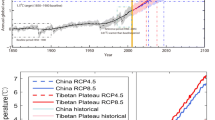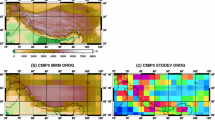Abstract
Rapid elevation-dependent warming (EDW) in high mountain environments can accelerate the rate of change in permafrost and further induce the degradation of alpine tundra systems. However, how changes in area of alpine tundra response to EDW is difficult to be directly quantified at regional scales. Here, we project future changes in areal extent of the Köppen “alpine tundra” climate type in the Tibetan Plateau (TP), which is a potential indicator describing the climate conditions for the development of alpine tundra system, based on a suite of latest Coupled Model Intercomparison Project Phase 5 (CMIP5) climate models under two emission scenarios (representative concentration pathways: RCP 4.5 and RCP 8.5). The results indicated that the Köppen “alpine tundra” climate type would gradually decrease in the TP for three future periods: 2011–2040, 2041–2070, and 2071–2100, especially under the RCP8.5 scenario. The decline in area of Köppen “alpine tundra” climate type mainly occurs above 2500 m above sea level (ASL) due to the EDW (> 10 °C) in the warmest months. The projected changes in area of “alpine tundra” climate type are overall consistent among different climate models, emission scenarios, and post-processing approaches (bias correction or not) used. The results obtained would thus deepen our understanding of future elevation-dependent warming and its potential influences on alpine tundra ecosystems in the Tibetan Plateau.





Similar content being viewed by others
References
Chen DL, Chen HW (2013) Using the Köppen classification to quantify climate variation and change: an example for 1901-2010. Environ Dev 6:69–79
Crosbie RS, Pollock DW, Mpelasoka FS, Barron OV, Charles SP, Donn MJ (2012) Changes in Köppen-Geiger climate types under a future climate for Australia: hydrological implications. Hydrol Earth Syst Sci 16:3341–3349
Diaz HF, Eischeid JK (2007) Disappearing “alpine tundra” Köppen climatic type in the western United States. Geophys Res Lett 34:L18707
Guo XY, Wang L, Tian LD, Li XP (2017) Elevation-dependent reductions in wind speed over and around the Tibetan Plateau. Int J Climatol 37:1117–1126
Köppen W (1936) Das geographische System der Klimate. In: Köppen W, Geiger R (eds) Handbuch der Klimatologie, vol 1 Part C. Verlag von Gebrüder Borntraeger, Berlin, p 1–44
Kottek M, Grieser J, Beck C, Rudolf B, Rubel F (2006) World map of the Köppen-Geiger climate classification updated. Meteorol Z 15:259–263
Li XP, Wang L, Guo XY, Chen DL (2017) Does summer precipitation trend over and around the Tibetan Plateau depend on elevation? Int J Climatol 37(Suppl.1):1278–1284
Liang YL, Wang YL, Yan XD, Liu WB, Jin SF, Han MC (2017) Projection of drought hazardsin China during twenty-first century. Theor Appl Climatol. https://doi.org/10.1007/s00704-014-2189-3
Liu WB, Sun FB (2016) Assessing estimates of evaporative demand in climate models using observed pan evaporation over China. J Geophys Res Atmos 121:8329–8349
Liu WB, Sun FB (2017) Projecting and attributing future changes of evaporative demand over China in CMIP5 climate models. J Hydrometeorol 18:977–991
Liu WB, Fu GB, Liu CM, Charles SP (2013) A comparison of three multi-site statistical downscaling models for daily rainfall in the North China Plain. Theor Appl Climatol 111:585–600
Liu WB, Zhang AJ, Wang L, Fu GB, Chen DL, Liu CM, Cai TJ (2015) Projecting streamflow in the Tangwang River basin (China) using a rainfall generator and two hydrological models. Clim Res 62:79–97
Liu WB, Sun FB, Lim WH, Zhang J, Wang H, Shiogama H, Zhang YQ (2018) Global drought and severe drought-affected population in 1.5 and 2°C warmer worlds. Earth Syst Dynam 9:267–283
Mountain Research Initiative EDW Working Group (2015) Elevation-dependent warming in mountain regions of the world. Nat Clim Chang 5:424–430
Pepin NC, Lundquist JD (2008) Temperature trends at high elevations: patterns across the globe. Geophys Res Lett 35:L14701
Qin J, Yang K, Liang SL, Guo XF (2009) The altitudinal dependence of recent rapid warming over the Tibetan Plateau. Clim Chang 97:321–327
Rubel F, Kottek M (2010) Observed and projected climate shifts 1901-2100 depicted by world maps of the Köppen-Geiger climate classification. Meteorol Z 19:135–141
Rubel F, Brugger K, Haslinger K, Auer I (2017) The climate of the European Alps: shift of very high resolution Köppen-Geiger climate zones 1800-2100. Meteorol Z 26:115–125
Shi Y, Gao X-J, Wu J (2012) Projected changes in Köppen climate types in the 21st century over China. Atmos Oceanic Sci Lett 5(6):495–498
Sun GY (2013) Study again on Qinghai-Tibet plateau tundra: determination of geography polarity for the third pole of earth. J Earth Sci Environ 25(3):97–105 (in Chinese with English abstract)
Wang GX, Bai W, Li N, Hu HC (2011) Climate changes and its impact on tundra ecosystem in Qinghai-Tibet Plateau, China. Clim Chang 106:463–482
Yang K, Wu H, Qin J, Lin CG, Tang WJ, Chen YY (2014) Recent climate changes over the Tibetan Plateau and their impacts on energy and water cycle: a review. Glob Planet Chang 112:79–91
Zhang XL, Yan XD, Chen ZJ (2017) Geographic distribution of global climate zones under future scenarios. Int J Climatol 37:4327–4334
Acknowledgements
The authors gratefully acknowledge the CMIP5 contributions (http://pcmdi9.llnl.gov/esgf-web-fe/) that served as the basis of the results reported here. We thank the editor and two anonymous reviewers for helpful comments.
Funding
This research was financially supported by the National Key Research and Development Program of China (2016YFC0401401 and 2016YFA0602402) and the Key Research Program of the Chinese Academy of Sciences (ZDRW-ZS-2017-3-1).
Author information
Authors and Affiliations
Corresponding author
Additional information
Publisher’s note
Springer Nature remains neutral with regard to jurisdictional claims in published maps and institutional affiliations.
Rights and permissions
About this article
Cite this article
Liu, W. Decreasing “alpine tundra” climatic type with global warming in the Tibetan Plateau. Theor Appl Climatol 137, 1949–1955 (2019). https://doi.org/10.1007/s00704-018-2722-z
Received:
Accepted:
Published:
Issue Date:
DOI: https://doi.org/10.1007/s00704-018-2722-z




